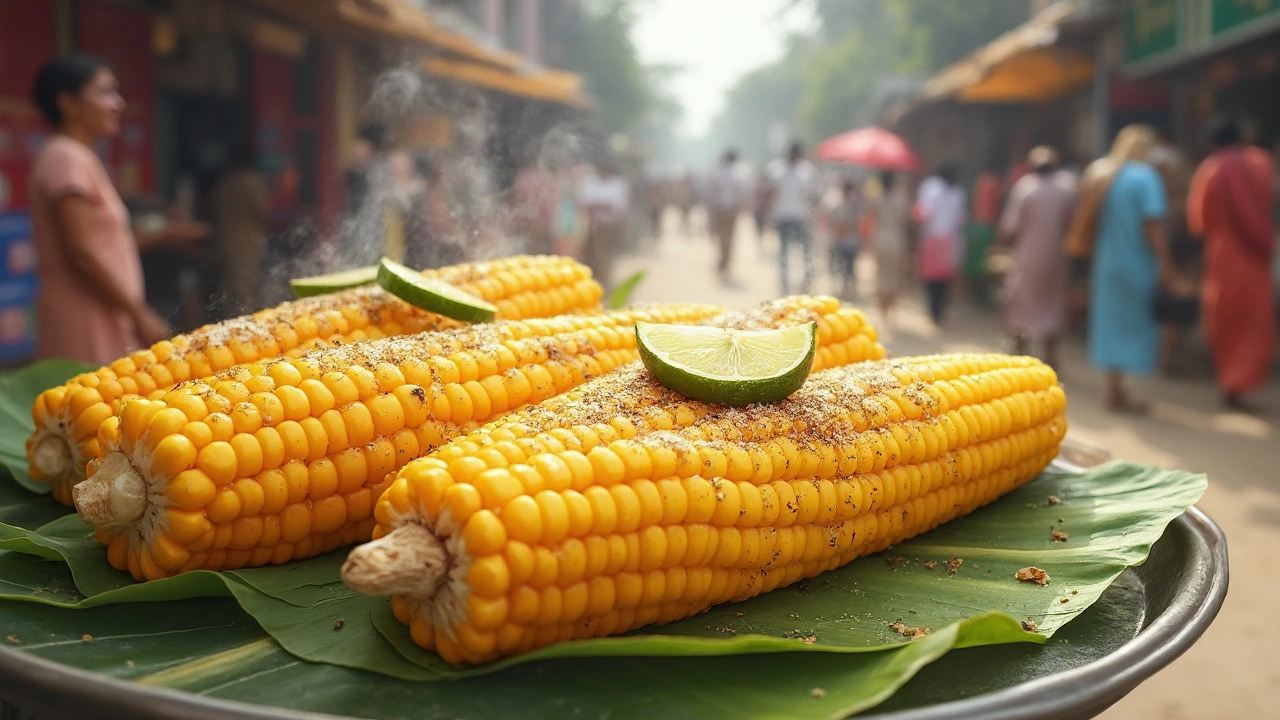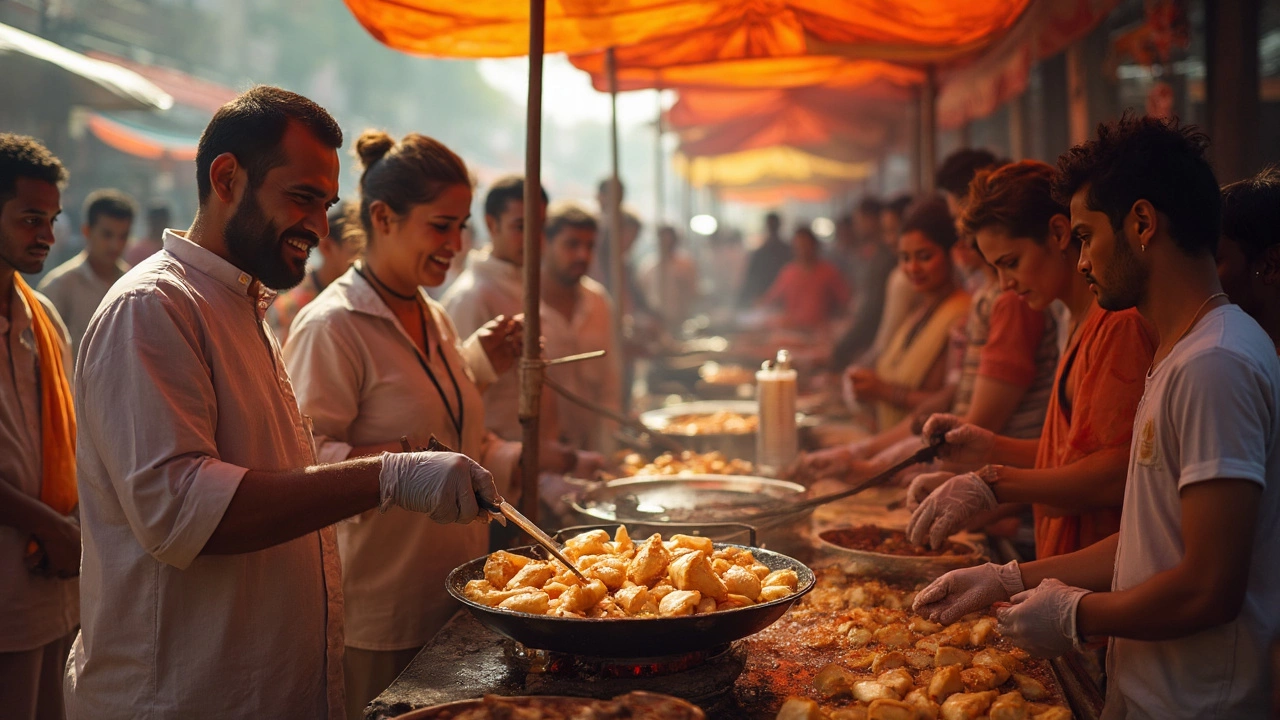For anyone traveling across India, skipping street food means missing out on the real heartbeat of local life. Still, no one wants their travel stories to turn into tales about food poisoning. The thing is, most stomach upsets happen not from the food itself, but from dirty water, poor handling, or stuff sitting out too long.
First rule: always check out the stall before you line up. Busy stalls with lines are usually a good sign—locals know where food is fresh and won’t make them sick. A steady crowd means the food turns over fast and doesn't just sit out in the heat. Don’t be shy about watching how the vendor prepares and serves food. If they handle cash and food with the same hands or have dirty fingernails, look elsewhere. You can learn a lot just by standing around and observing for a minute.
- Scout the Right Stall
- Check the Food and Prep
- Order Like a Local
- Drinks: Don’t Slip Up
- Be Ready If Trouble Strikes
Scout the Right Stall
If you want to enjoy street food India style without getting sick, start by picking your spot wisely. Not all stalls are created equal. Some have cleaner practices and fresher food, while others are best skipped. Let’s break down what you should look for.
- Look for crowds: A busy stall is usually a safe bet. High turnover means the food doesn’t sit around long enough to spoil, and locals tend to stick with places that haven’t let them down.
- Watch the vendor: Are they using gloves or tongs? Do they touch money and food with the same hands? Clean habits are a good sign. Dirty fingernails or hands covered in sauce? Time to move on.
- Check the setup: Food should be covered when not being served. Avoid stalls with flies buzzing around. Smell counts too—if you catch a whiff of something sour or rotten, walk away.
- Location matters: Stalls near markets, schools, or offices tend to be busier and safer since more people eat there daily. Skip ones near trash heaps, open drains, or piles of uncleared waste.
- Prep in public: The best street food is made right in front of you. If you see pre-cooked dishes just reheated or food sitting on trays for hours, it’s risky.
For a quick look at what separates safe stalls from sketchy ones, here’s a handy checklist:
| Safe Stall | Sketchy Stall |
|---|---|
| Busy, crowded with locals | Empty or rarely visited |
| Clean prep area and utensils | Utensils crusted with old food |
| Food made to order | Old food left out uncovered |
| Vendor uses utensils to serve | Vendor handles food and money together |
Don’t be afraid to ask questions—"How fresh is this?" or "When was this made?" Vendors are used to it, especially in bigger cities. If you don’t feel good about a place, trust your gut. Your next favorite dish is probably just a few stalls down.
Check the Food and Prep
It's tempting to order whatever looks good, but a close look at how the food is made can save you a lot of pain later. Plenty of street vendors get it right—they use fresh ingredients, cook everything in front of you, and keep things clean. But not every stall is the same. In India’s intense heat, bacteria multiply fast, especially if food sits out uncovered.
Always go for food that is cooked or fried on the spot. Fresh bhajiyas, samosas, dosas, and grilled kebabs are safer than salads or food prepped hours ago. The general rule? If you can’t see it being made or heated, don’t risk it.
- Look for steam or sizzle. Hot and freshly made is your friend. If you see a pile of food just sitting out, skip it.
- Vegetarian dishes are a safer bet, especially during hotter months. Meat dishes spoil more quickly without refrigeration.
- Check how ingredients are stored. Covered containers and using clean utensils say a lot about hygiene.
Surveys by the Food Safety and Standards Authority of India (FSSAI) show that most reported cases of stomach issues from street food India come from food left uncovered or handled without gloves.
“The key is to observe how the vendor manages hygiene and cross-contamination. If something feels off, trust your instincts.” — Dr. Aruna Sharma, Public Health Specialist
Certain items carry bigger risks. Chutneys and sauces, for example, often contain uncooked ingredients and might be mixed with tap water. If sauces are served cold or come from a giant bowl that looks like it’s been there all day, better to avoid them.
| Street Food Item | Safer When... | Risk Level |
|---|---|---|
| Samosa | Fried in front of you | Low |
| Pani Puri | Served with bottled water | Medium |
| Fruit Chaat | Prepped with clean water, covered | High |
| Chutneys | Cooked or steaming hot | High |
Wanna play it extra safe? Carry your own disposable spoons or forks. A lot of people do it nowadays, especially parents like me who have kids with sensitive stomachs. Watching prep, checking for cleanliness, and noticing how food is handled are small steps, but trust me, they make a huge difference.

Order Like a Local
If you want to go beyond playing it safe, copy what the locals do. People who eat street food regularly know exactly how to order, what questions to ask, and which items to avoid on a hot day. Their habits are smart shortcuts for visitors too.
For starters, always ask for food to be freshly made if you can. In places like Delhi and Mumbai, popular orders like samosas or pav bhaji are often cooked in batches, but locals will politely insist, "Bhaiya, naya dena please" (give me a fresh one, please). If you see something sitting out for hours, skip it.
- Watch for piping hot food. Chaat and samosas might look harmless, but lukewarm means bacteria have had a chance to move in. Hot food is almost always safer.
- Go for cooked stuff over raw. Salads, fresh chutneys, and yogurt may seem healthy, but they’re risky. Most regulars avoid anything that’s been washed in tap water or exposed to flies.
- Don’t hesitate to point to what you want. If it looks like locals are customizing spice levels or toppings, do the same, and ask for less raw onion or mint if you’re unsure.
- Check if the vendor handles money and food with the same hands. Locals walk away if they see sloppy hygiene. No shame in doing that too.
And here’s a trick straight from Indian parents: always carry wet wipes or small hand sanitizer bottles. Kids often get sticky fingers around pani puri stalls, and it’s one reason families keep sanitizer close. Don’t rely on washing your hands at roadside taps since clean water isn’t guaranteed.
| Food Item | Risk Level | Safe Ordering Tip |
|---|---|---|
| Pani Puri | High | Ask for dry puri or use bottled water |
| Bhel Puri | Medium | Skip raw onions and chutney |
| Samosa | Low | Order straight from the fryer |
| Pav Bhaji | Low | Ensure it's served hot |
| Fruit Chaat | High | Avoid raw, pre-cut fruit |
Eating street food India style means blending in, asking questions, and knowing when to politely walk away. Stick to the stalls with a crowd, watch what seasoned eaters do, and never feel embarrassed about looking fussy—Indians do it all the time.
Drinks: Don’t Slip Up
Honestly, drinks can trip up even the most careful eaters. Water is the usual suspect when folks end up with a dodgy stomach, and that includes what’s used in juices, ice, and even “filtered” bottled water. Don’t trust anything that isn’t factory-sealed. The safest move? Buy only big-name brands of bottled water and always check the seal; it should make that click sound when you twist it open.
Street vendors love to serve up fresh lime soda or sugarcane juice. Yeah, they taste amazing, but most of these are made with water and ice you can’t guarantee is clean. Even the glass might just get a lazy dip in a bucket before coming your way. Skip the ice in all drinks (especially in the hot months) and watch the stall’s cleaning setup: if it’s just a worn-out bucket of gray water, go somewhere else.
- Stick to drinks made in front of you with fruits you see peeled right there, like coconuts. Coconut water straight from the shell is both safe and super hydrating.
- If you want chai, pick stalls where water comes to a rolling boil—boiling kills most germs.
- Sometimes juice shops will show off their “purifier,” but unless you watch them switch filter cartridges right there, it’s just for show.
Most cases of travelers’ diarrhea in India have one thing in common—contaminated drinking water. Studies show over 80% of Delhi's street food stalls were found to use water that failed safety tests in a 2022 municipal survey. Those are rough odds.
| Drink | Risk Level (1=Low, 5=High) | Safe Choice? |
|---|---|---|
| Factory-sealed bottled water | 1 | Yes |
| Open cup sugarcane juice | 5 | No |
| Fresh coconut water | 1 | Yes |
| Chai from boiling pot | 2 | Usually |
| Drinks with ice | 4 | No |
Bottom line: Treat street food India drinks as potential landmines. Play it safe and your belly will thank you.

Be Ready If Trouble Strikes
Even the savviest travelers can get unlucky, especially with street food India classics. Sometimes, despite all your careful stall scouting and following food safety tips, your stomach just doesn't agree. Here’s what you need to know if street food bites back.
First, almost all cases of "Delhi Belly" (traveler’s diarrhea) clear up in a day or two, but you need to stay hydrated. Indian summers are harsh, and losing fluids makes you feel ten times worse. Keep oral rehydration salts (ORS) handy. You can get them at any pharmacy, and they work wonders. Pack a couple before you even leave for your trip or grab some after arriving—they only cost a few rupees.
- If you feel sick, drink bottled or boiled water only—skip juices, tap water, and ice.
- Eat light: plain bread (roti or toast), bananas, and rice can help settle your system.
- Avoid dairy, spicy curries, and fried snacks until your stomach calms down.
- If you have fever, blood in your stool, or diarrhea lasting more than 48 hours, see a doctor. Medical care in Indian cities is affordable and easy to access.
Keep some basic meds in your bag: something for tummy trouble (like loperamide), paracetamol for fever, and a couple of antiseptic wipes. Local chemists usually speak English and can help with brand recommendations.
| Common Problem | Home Fix | When to Get Help |
|---|---|---|
| Mild upset stomach | ORS, water, bland food | If lasts >2 days |
| Fever > 101°F (38°C) | Rest, paracetamol | After 24 hours or with other severe symptoms |
| Dehydration (dizziness, very dry mouth) | ORS every 4 hours | If unable to keep liquids down |
| Severe cramps with blood | None at home | See a doctor right away |
If you’re traveling with kids like my daughter, Anaya, be extra watchful—they can get dehydrated faster than adults. Trust your gut, literally. If something feels off after a meal, it’s okay to take a break from adventurous foods until you bounce back.
